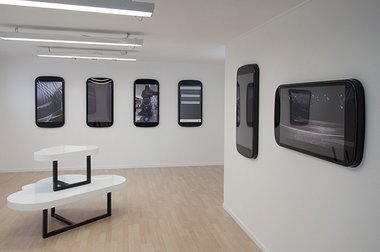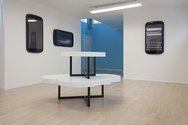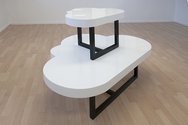John Hurrell – 4 June, 2013
No cold perforated steel sheets this time. Instead moulded styrene is used with a warmer, plastic, highly reflective tactility. Also many of Till's ten sculptures are in pairs; couples that though listed in the catalogue with separate names, are similar - and which have a dialogue of sorts.
Francis Till‘s last show at Gloria Knight’s almost a year ago focussed on 3G technology, its transmission and reception, presenting projecting metal sculpture that referenced delicate aerials and chunky cellphones. This new show is still sculpture, but this time wall hugging reliefs that depict smartphones - particularly the palm-fitting Samsung variety that uses Android systems. And on this occasion photographic imagery is incorporated within round-cornered, vertically rectangular frames.
This exhibition has a different feel. Literally. No cold perforated steel sheets this time. Instead moulded styrene is used with a warmer, plastic, highly reflective tactility. Also many of Till’s ten sculptures are in pairs; couples that though listed in the catalogue with separate names, are similar and which have a dialogue of sorts. Two are freestanding, stacked up cloud-shaped tables that allude to offsite data storage systems. Another is a suspended lamp: a cluster of LEDs surrounded by hanging, tentacle-like, USB laptop cables.
Of the Samsung wall works, those in pairs are linked by the same times or information in their titles. Most of the common devices are apparent, such as touchscreen scroll bars, camera controls, sent and received message bubbles, keyboards and clocks. The tonal and textural distinctions between some of the states (eg.incoming /outgoing, waking /passive) is subtle.
So what is Till up to here? Is he satirising his own generation, commenting on the paradoxical fact that obsession with ‘social’ media can also be anti-social, a withdrawal from awareness of one’s own immediate (ie. proximity to body) nondigital environment? Do the works embody critique or are they concerned with matter-of-fact observation? Is he simply infatuated with this technology without saying anything further that’s interesting: a form of adoration or fetishism perhaps?
Their scale, shape and reflective mirrorlike surfaces hint at social commentary, as if he were following in the tradition of the Italian artist Michelangelo Pistoletto whose life-sized photorealist images of people in the early sixties were screened onto full length mirrors to invite comparison with the reflected viewer. As commodities these sculptures might also be compared with the Pop Art imagery of Lichtenstein, Warhol or Oldenburg. In this country, Till’s phones - as abstract objects - are more akin to the work of Sarah Munro with her impeccable, powder-coated wall reliefs.
Although technically Till’s artworks are digital photographs inserted into unusually moulded ‘sculptural’ frames, because they are thin and elegant, in our imagination we can envisage them as scaled up smartphones for Brobdingnagians - and touch-sensitive so Lilliputians like us can stand close and talk, text or surf at will. They dissolve spatial boundaries with impact because of their size, being almost doorways or large vertical portholes, mentally creating a sense of geographical compression, compacting distant locations into one.
John Hurrell











 Advertising in this column
Advertising in this column Two Rooms presents a program of residencies and projects
Two Rooms presents a program of residencies and projects



This Discussion has 0 comments.
Comment
Participate
Register to Participate.
Sign in
Sign in to an existing account.